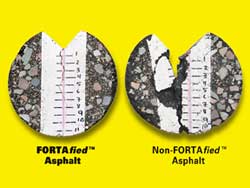Arizona State University Study
In coordination with FORTA® Corporation and the City of Tempe, Arizona, an asphalt mixture overlay was placed at Evergreen Drive (East of the Loop 101 and North of University Drive) in Tempe. The designated road section within the construction project had two main asphalt mixtures: a control mix with no fibers added and a mixture that contained 1-lb of fibers per ton of asphalt mixture. Mixtures for laboratory testing were sampled during construction and brought back to the Arizona State University (ASU) laboratories. Mixture preparation included compaction of 150 mm diameter gyratory specimens for triaxial testing, and beam specimens prepared and compacted according to AASHTO TP8 test protocols. The target air void levels for the test specimens were those typically achieved in the field (about 7%). Rice gravities were determined for the loose mixtures, as well as thickness and bulk densities measured in preparation of the testing program. Laboratory experimental programs included: triaxial shear strength, dynamic (complex) modulus, and repeated load for permanent deformation characterization; flexural beam tests along with flexural toughness tests for fatigue cracking evaluation; indirect diametral tensile tests for thermal cracking mechanism evaluation; C* Integral test for crack growth and propagation evaluation. The data was used to compare the performance of the fiber-reinforced mixtures to the control mixture.
Binder Characterization
Triaxial Shear Strength Test
Permanent Deformation Tests – Static Creep / Flow Time Test
Repeated Load Flow Number Test
Dynamic (Complex) Modulus Test
Fatigue Cracking Testing
Flexural Strength Test
Indirect Diametral Tensile Test
Crack Propagation Test – C* Integral
After the relationships between crack growth rates as well as slopes of crack growth rates for the 1 lb/Ton dosage of FORTA-FI® mixture and the control mixture were developed, it was noted that the fiber-reinforced mixture had higher C* and slope values than the control mixture. This means that the fiber-reinforced asphalt mixture has a higher potential to resist crack propagation because of the reinforcement effect provided by the reinforcing fibers.
(dU*=Change in energy rate for a load P and a crack extension dC, B=thickness)

Download Reports and Data Sheets
Click on a link below to download.
